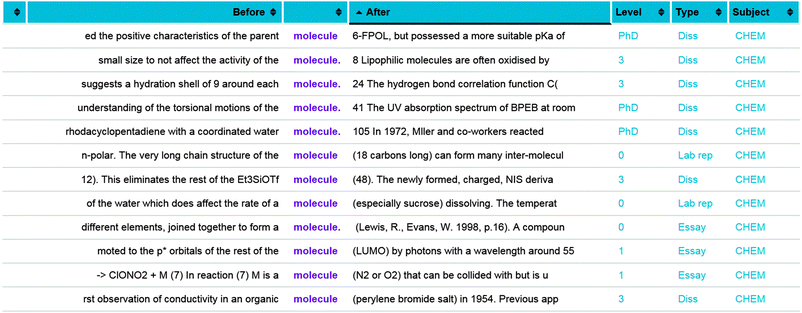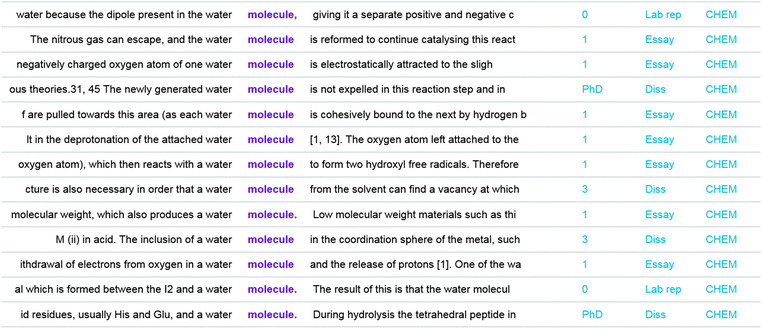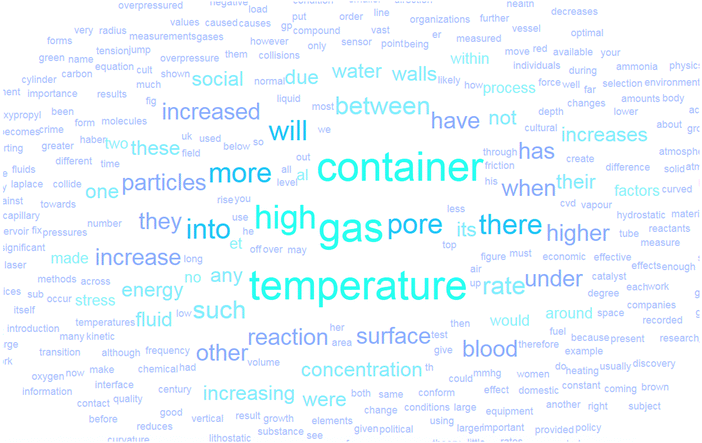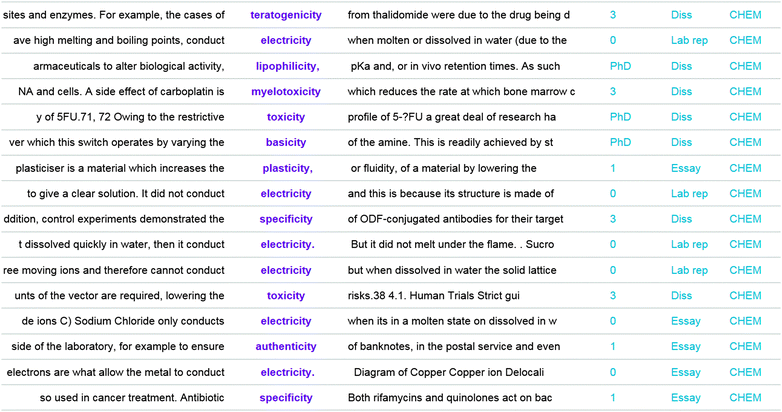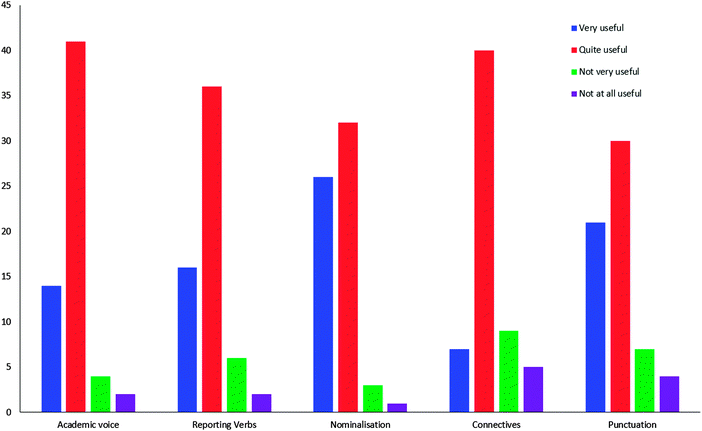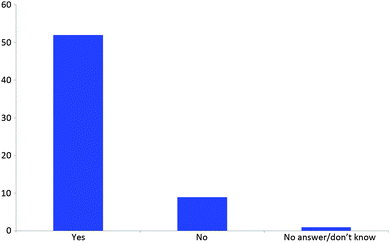Write on the edge: using a chemistry corpus to develop academic writing skills resources for undergraduate chemists
M. L.
Bruce
*a,
P. K.
Coffer
b,
S.
Rees
a and
J. M.
Robson
 *b
*b
aFoundation Centre, Durham City Campus, Durham University, Durham, DH1 1TA, UK. E-mail: megan.bruce@durham.ac.uk
bDepartment of Chemistry, Durham University, South Road, Durham, DH1 3LE, UK. E-mail: j.m.robson@durham.ac.uk
First published on 2nd March 2016
Abstract
Many undergraduate students find the production of an extended piece of academic writing challenging. This challenge is more acute in the sciences where production of extended texts is infrequent throughout undergraduate studies. This paper reports the development of a new English for Academic Purposes (EAP) workshop and associated resources for third year undergraduate chemists to support their dissertation module. The workshop is designed to utilise a searchable database of student texts (a corpus) developed as part of the FOCUS project at Durham University. This novel use of data-driven learning (DDL), common in second language pedagogy, transfers well to the chemistry classroom as the processes of research and discovery (of words rather than chemicals) involved in DDL parallel similar processes in chemistry research. Our workshop and online consolidation activities have been positively evaluated by both staff and our current cohort of students. The project is being rolled out across other departments at Durham as well as the corpus tool being utilised at other UK HEIs. This corpus-based approach to academic writing in chemistry offers a unique perspective on the interplay between language and scientific literacy.
Introduction
Learning by writing is an established pedagogical tool and key professional skill in chemistry (Kovac and Sherwood, 1999), but many chemistry students have had limited experience of extended scientific writing and find it challenging to express their detailed subject knowledge in an appropriate academic style. Third year undergraduate chemistry students at Durham are required to produce a scholarly and critical review of a narrow area of relevant chemical literature. In many cases, this is the first time they have been asked to produce such a piece during their degree studies and many will not have written any extended text since before their A-level (or equivalent) secondary school courses. There is wide coverage in the literature (e.g.Taber, 2002, 2015) about students' handling of chemistry technical language, with a focus on developing their understanding of chemistry-specific terminology or avoiding misconceptions. Less has been written about developing the ability of chemistry students to write extended texts. Over the last 25 years, academic writing has developed as a research subject at UK HEIs and it is widely acknowledged that writing skills tuition will be required during university in order for students to reach their full potential in this area (Ganobcski-Williams, 2006). Alexander, Argent and Spencer (2008) describe academic discourse communities as “like tribes with territories [and] …a major aim of EAP practice is to help… [students] to become academic ‘insiders’” (Alexander et al., 2008, p. 9). The explicit teaching of different writing genres (e.g. essay, research report, literature survey) and microwriting skills (paraphrasing, summarising, criticality, using evidence, writing formally) are increasingly part of the university curriculum in some format. Nesi and Gardner (2012) use data from their BAWE corpus to argue for the existence of 13 separate academic genres: one of which is Literature Survey which is the focus of our project.At Durham, dissertation supervisors provide the necessary chemistry-specific guidance for the assignment; however it was noted that there was still a gap in support for students who struggled to express their accurate chemical knowledge in an appropriate academic genre.
The problem
Feedback from dissertation supervisors identified that many students experienced problems with the structure of their assignment and support with this, rather than discussion of the relevant chemistry, was the focus of many supervisory meetings. The lack of explicit linguistic knowledge of many chemistry students meant that, despite often being able to synopsise the chemistry content competently, they struggled to construct a coherent narrative in an appropriate academic voice. The supervisors provided detailed guidance with the chemistry aspect of the assignment, but although they had long been able to identify problems with the written style, their feedback (e.g. ‘it's a bit informal’ or ‘you say ‘I’ and ‘they’ a lot!’) did not lead to significant improvements in the standard of writing.In previous years, this training requirement was addressed by the provision of a discrete English for Academic Purposes (EAP) workshop delivered by university staff external to the department. However, neither supervisors nor students felt that this style of workshop addressed the main concerns. Students reported difficulties engaging with the material as it was delivered in a generic format, using non-subject-specific, non-context-based examples, and addressed linguistic principles in a technical way. Supervisors shared these concerns. The EAP workshop was one of five skills workshops delivered as part of the dissertation module, namely: preparation of long documents, presentation skills, ChemDraw, information retrieval and academic writing.
When asked to evaluate how informative and useful each of these workshops was, the average rating for the EAP workshop was the lowest across a two year period (see Table 1).
| Workshop | Overall student rating (%) |
|---|---|
| Presentation skills | 71 |
| ChemDraw | 69 |
| Information retrieval | 61 |
| Preparation of long documents | 49 |
| Academic writing (EAP) | 46 |
It was interesting to note that the presentation skills and ChemDraw workshops were delivered by chemistry department staff, and it can be seen from Table 1 and the free text comments that these were valued the highest by students. The three workshops that students responded to less well were delivered by university staff external to the department. It can be seen that the academic writing workshop received the lowest scores from students in terms of usefulness. It was clear from student comments that the general nature of the EAP workshop made it less valuable and that there was a preference for a workshop that was more chemistry-specific:
“…often the advice being given was very general and in particular the lecture on academic writing contained some advice that did not apply to the literature perspective we were expected to write.”
“[the workshop leader] was not aware of the departmental guidelines on summative written work… I feel that a member of the department could have given a much better session on scientific writing.”
“…at the end I was still unclear on how the scientific style differed from my previous essays and how to write critically. I feel the [workshop] would have benefited from more examples.”
Based on this qualitative and quantitative feedback, a need was identified for an EAP workshop for delivery by chemistry staff. The department was already contributing to a scientific language support initiative running elsewhere in the university and it was decided to extend this collaboration to ensure appropriate linguistic support in the workshop design. The aim was to allow students with little linguistic knowledge to uncover grammatical principles in a comprehensible and chemistry-specific way and then apply these principles to improve their academic writing.
The solution
There have been numerous reports of ways in which chemistry departments have approached developing the academic writing skills of their undergraduates (e.g.Bressette and Breton, 2001; Gordon et al., 2001; Whelen and Zare, 2003; Stoller et al., 2005); however none of these have involved students mining good examples of the target text to deduce writing principles (a process known as data-driven learning). The use of data-driven learning (DDL) is well-established in language classrooms because this process of discovery helps students to understand linguistic principles even when they do not have the vocabulary to express them.How to support writing development in the absence of meta-language: data-driven learning
Johns (1991) coined the term “data-driven learning” to describe a learning situation where “the language learner is also, essentially, a research worker whose learning needs to be driven by access to linguistic data – hence the term “data-driven learning” (DDL) to describe the approach” (Johns, 1991, p. 2). In DDL the learner uses data to uncover the rules behind the language while the teacher “provides a context in which the learner can develop strategies for discovery” (ibid).DDL using corpora (collections of specialist texts) and concordancing programmes (computer interfaces used to show the textual occurrences of words in the corpus) has been commonly used in language classrooms for the last twenty years. However, although its use is widespread, it has been focused mainly on the learning of second languages (L2s). The use of concordancing in a native speaker context is much less well established, yet the methodology fits well with the needs of our native speaker students who do not have the meta-language to be taught about their linguistic deficits explicitly. Some chemistry undergraduates are, of course, learning in a second language but the majority are native speakers who are aiming to develop an academic writing style. No-one's first language is Academic English, so L2 methodologies are very applicable in this context. In addition, the processes of research and discovery (of words rather than chemicals) involved in DDL parallel similar processes in chemistry research.
DDL involves a process of discovery which does not rely on the students having any kind of meta-language or linguistic knowledge to underpin the skills they are acquiring. Gabrielatos (2005) points out the added value to this method: that it helps to develop criticality which is a crucial element of learning. It moves away from “single correct answer” towards understanding importance of patterns, alternatives and context.
This paper will report the development of a new English for Academic Purposes (EAP) workshop for third year chemists, designed to utilise a searchable database of student writings (a corpus) developed as part of the FOCUS project. This corpus has been created at the Foundation Centre to help develop key academic literacy skills in a number of subjects using a range of Durham University student writings at undergraduate and postgraduate level and is now being rolled out for use across all areas of academic endeavour (Bruce and Rees, 2013). Good examples of the chemistry extended writing assignments have been added to the corpus over the last three years as part of an ongoing project. The corpus now provides a valuable resource for students to explore when developing their academic writing skills to produce their own version of this assignment.
The FOCUS corpus
Since 2012, a project known as FOCUS (FOundation CorpUS) has been developed at Durham University Foundation Centre. The remit of the Foundation Centre is to widen access to Durham University for non-traditional applicants. Foundation Centre students may be mature students who have been out of traditional education for a number of years, or have been educated in a language other than English. The lack of familiarity of Foundation students with the written skills required for degree studies at British HEIs resulted in the creation of FOCUS to address these needs. FOCUS is a corpus of academic texts produced by Durham University students from a range of departments across all levels of study. This corpus is searched using a bespoke concordancing programme with a deliberately simple, non-linguistic interface. Texts currently range from level zero (Foundation students who are pre-undergraduate) to PhD level and have been gathered from a range of departments, including chemistry, across the three faculties at Durham University. The texts we have included in the corpus have been selected to exemplify key genres of writing in each discipline. They have also been assessed as strong examples of academic work by their department, and have been awarded a 2![[thin space (1/6-em)]](https://www.rsc.org/images/entities/char_2009.gif) :
:![[thin space (1/6-em)]](https://www.rsc.org/images/entities/char_2009.gif) 1 or above for their academic content.
1 or above for their academic content.
Much has been written about the underlying principles of corpus building. Some researchers such as Tribble (1997) do not believe that apprentice performances belong in a corpus. However, the FOCUS team contends that student writings are defined as expert performances in our project, since our aim is to use the corpus to teach students to produce good examples of university assignments. Moreover, Seidlhofer (2002, p. 214) argues that focusing on a learner corpus has “an essential pedagogical advantage, especially if it includes whole texts from the learners working with it”.
During our approaches for student texts, some academic departments expressed concern that our corpus could turn into an essay bank from which students could plagiarise. In fact, this would not be a possible use of the corpus data: as can be seen from Fig. 1, a search for a particular word reveals only the keyword plus around 40 characters of text either side, totalling 100 characters per line.
Clicking on a single instance of the keyword gives a slightly larger text fragment, but still only around 200 characters. No coding is made available to the user which would allow them to identify and piece together fragments to form a complete assignment.
Concordancer design and functionality
Johns (1991) defines a concordancer as:“able to recover from the text all the contexts for a particular item (morpheme, word or phrase) and to print them out in a way which facilitates rapid scanning and comparison. The most usual format is the keyword-in-context (KWIC) concordance in which the keywords are arranged one below the other down the centre of the page, with a fixed number of characters of context to the left and right. A useful refinement, particularly where one is concerned with regularities and patternings in large numbers of citations, is the ability to sort alphabetically the contexts to the left or right of the keyword so that similar contexts are grouped together.” (Johns, 1991, p. 2).
A more concise definition from Tribble (1997, p. 11) states that “What the concordancer does is make the invisible visible”.
Our concordancer can be accessed online at: http://community.dur.ac.uk/foundation.focus/external. Visitors to the site also see a YouTube demonstration of the tool and can access our blog and twitter feed.
A user can perform a simple search by just entering a keyword. This can be a word, morpheme (using our wildcard symbol %) or phrase. A more advanced search can also be performed which limits the findings by level (e.g. UG/PG), type (e.g. essay/lab report) or subject (e.g. Chemistry, Physics).
The screen can be set up to show 50, 100 or 200 concordance lines and it chooses a random sample from the total held in the corpus. Users can sort the data alphabetically using the “Before” or “After” tabs to identify common collocations. So, for instance, it can be seen in Fig. 2 that the most common collocate of “molecule” is “water”.
The tool also includes a word cloud feature to identify common collocations and guide users into useful explorations about their keyword (see Fig. 3).
Another feature of the tool is its wildcard function using the % symbol. This allows users to search for all forms of a word family, so searching for combin% would give: combination, combinations, combinatorial, combine, combines, combined, combining.
The wildcard symbol also allows users to explore particular affixes, such as the search results shown in Fig. 4 for %icity.
Clicking on the central column would alphabetise the keywords with the -icity suffix and allow users to see which ones occur most frequently. Students can also use this type of search to deduce the meaning of various affixes, which in turn improves their ability to guess at the meaning of unknown words in the future. This activity is available as a YouTube screencast (http://www.youtube.com/watch?v=s3Ep06t3e-M).
The workshops
The workshops were developed with input from both chemistry and FOCUS project staff. The pilot versions were delivered by an EAP specialist on the FOCUS team with departmental staff observing and assisting. The new corpus-based pilot workshop was trialled alongside the old-style didactic and non-context-based training sessions to allow for some direct comparison. Student feedback was obtained from all three pilot workshops, and revised compulsory workshops were subsequently developed for the whole cohort the following academic year. The first of these was delivered by a member of chemistry staff with assistance from the linguist on the FOCUS team, and, following final amendments, the workshops are now stand alone and sustainable and will run without the necessary presence of the specialist linguist.Evaluation of the impact of the pilot and final workshops was primarily by anonymous student surveys. This method was chosen as it reflects student confidence in and perception of the quality of the training offered. The questions were posed using a four point Likert scale and allowed for additional free text comments. The large number of factors affecting final student grades for the assignments, including engagement with the scientific content and scientific language used, meant that quantitative analysis of assignment grades would be problematic. The marking component where academic writing style was directly assessed was combined with other aspects such as structure, figures and diagrams and referencing, thus analysis of these marks are unlikely to provide information that refers directly to the workshop intervention itself. It was noted, however, that the marks for the relevant section assessing the quality of scientific writing and spelling, punctuation and grammar (as well as other aspects) did increase slightly after the intervention, from an average mark of 12.87/20 (standard deviation 1.52, n = 67) to 13.02 (standard deviation 1.37, n = 86). The average overall assignment mark increased slightly from 65.3% to 66.0%. The combination of the relevant aspects being combined with other criteria, however, means no firm conclusion can be drawn from this data about the effectiveness of the workshops. Student survey opinion of the activities was deemed to be the most appropriate method of analysis.
The activities
The initial pilot sessions focused on five activities listed below, the content of which form the basis of a typical “English for Academic Purposes” course curriculum but in this case embed the use of the FOCUS corpus to allow data-driven learning.The connectives activity in particular has been identified as a difficult area in scientific writing (Wellington and Osborne, 2001) whilst the other activities are fundamental for students unfamiliar with producing extended discourse.
The delivery
For each activity, students were first introduced to a concept, then used the corpus to find relevant examples of the concept in texts produced by chemistry students. They were then presented with an extended chunk of ‘real’ chemistry text, taken from an assignment produced in a previous year but adapted and amended to display some of the common errors and mistakes relating to each of the activities. Students worked to identify the errors in the text, and to correct them by finding better examples from the corpus. A ‘bottom-up’ approach, beginning from chemistry examples of a ‘good’ and ‘less good’ sentence saying the same thing in different ways, was used to explain each concept before specific EAP terminology was introduced. For our students, this compares favourably with the previous approach of introducing the abstract concept using language terminology (e.g. nominalisation) prior to the explanation and application of the concept itself to a non-subject specific example. Students feel as though the activity is academically rigorous without being confused by initially unfamiliar vocabulary.Using a corpus in the classroom allows students to see many more examples (up to 200) of the target language in context than would be possible through looking at individual texts. As a specific example, when completing activity 3 (Nominalisation), students began by using the corpus to find the number of instances of the verbs treat and develop compared with the number of instances of the nouns treatment and development. This immediately demonstrated to them the prevalence of noun forms in academic chemistry texts and illustrated, in context, the process of nominalisation. Students were then provided with a longer, complete chemistry text on a worksheet and worked in pairs to nominalise some of the phrases in it.
Pilot workshop feedback
The first pilot workshop was optional and ran alongside the pre-existing unpopular EAP provision. Fourteen participants volunteered to attend the first session and completed feedback questionnaires. Initially, only the first four activities listed above were covered in depth.Nominalisation proved to be the area participants considered to be the most useful. The majority of responses specifically mentioned this exercise as the most useful to develop for further training, including:
“Nominalisation was new to me and a skill/tool I would like to develop to give me the right tone.”
It was evident during the activity was that nominalisation was a new concept to many and they engaged with the new ideas keenly and with interest. “Connectives” and “Reporting verbs” were also considered by participants to be useful areas to develop further. All participants indicated that they would be likely to access the corpus outside the classroom to further their own academic writing development, with comments including:
“[I would use it] to see if certain words I write are academically acceptable.”
“It allows me to compare the language I am using to previous work that has received a good mark. This is useful.”
“Useful to check whether [a] chosen word is common in dissertation[s].”
One of the more positive areas of the workshop was the context-based nature of the resources chosen from the corpus to illustrate the concepts:
“[the most useful part was] the use of real texts and not made up texts. Though edited, there was more realism.”
Three responses suggested that the Academic voice section was not very useful:
“The first activity about informal language wasn't very useful as the learning outcomes are fairly obvious”
“The academic voice was least useful. Less time could have been spent”
“Spotting the informal words – too easy but funny”
There were still mostly positive responses, however, when asked to rate the usefulness of all activities (see Fig. 5).
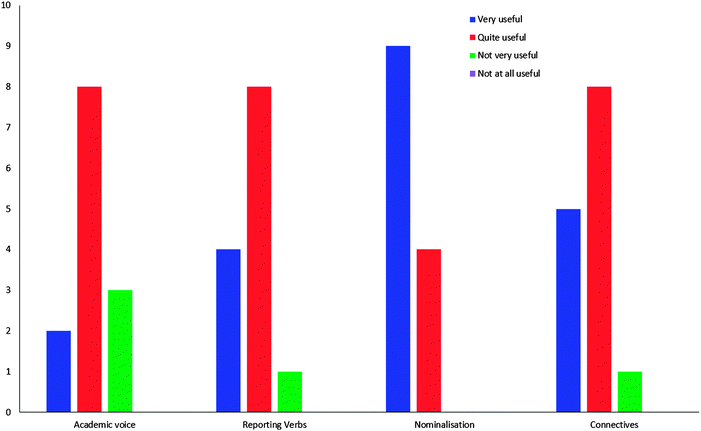 | ||
| Fig. 5 Chart showing student responses to the question “How useful did you find the activities” run during pilot workshop 1. n = 14. | ||
Three of the participants had also attended the traditional EAP training and were able to comment about the differences between the two workshops. One student, in discussion, felt that the interactive and chemistry-based nature of the new corpus workshop was more helpful than the original, more abstract and didactic EAP workshop.
Although there was some negative feedback about the academic voice activity, it was felt it acted as a good starter activity and also allowed students to familiarise themselves with the corpus using a concept they are already familiar with. The time spent on this activity, however, was cut down for subsequent workshops. The initial workshop did not include a section on punctuation, but specific feedback requesting “More grammar-specific exercises e.g. punctuation” led to the development of an additional section in the workshop to cover key punctuation issues.
The second and third pilot workshops were run a day apart a few months later when students were further on with the extended writing assignment. Nineteen voluntary participants attended across two workshops. This second phase saw the introduction of the punctuation activity in response to initial feedback. This proved to be one of the most popular activities (see Fig. 6), with nominalisation again featuring highly in the most useful categories.
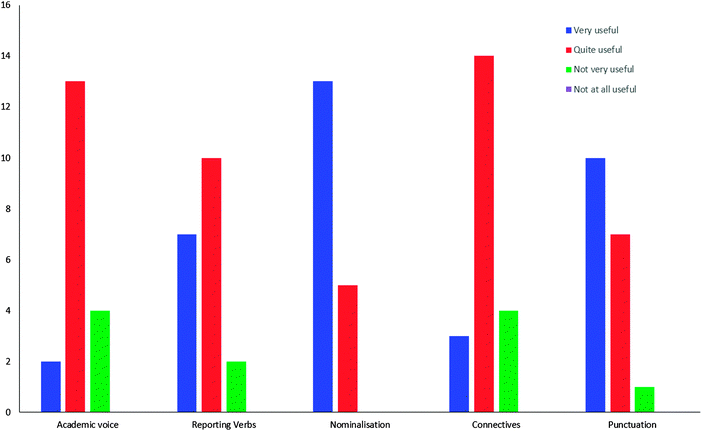 | ||
| Fig. 6 Chart showing student responses to the question “How useful did you find the activities?” run during pilot workshops 2 and 3 (combined data). n = 19. | ||
It was interesting to note that the punctuation activity was very well received in the most part, but there were some negative comments including “…I don't think I will use much of it.” There were numerous comments about the academic voice activity being ‘too easy’, yet it was decided to retain this in the session as departmental staff identified informality as a key weakness in this assignment and it provided a useful platform for students to develop some familiarity with the corpus tool which they would subsequently use in more demanding activities.
Feedback from the pilot phase was considered cautiously since the participants were volunteers and as such likely to be the most engaged of the student body, but the refined workshop model was rolled out to the whole cohort the following academic year.
Revised workshop feedback
All level 3 chemists were required to attend the workshop and the previous EAP training was discontinued. 94 attended the workshops, with 62 providing feedback (66% response rate). It was anticipated that this larger sample size, and the compulsory nature of the workshop, would produce more variation in responses when compared with the pilot feedback. The results, however, did not show significant difference. Nominalisation and punctuation were again rated highest in the ‘very useful’ category (see Fig. 7).Fig. 8 shows the number of students who would be likely to access the corpus independently away from the workshop. There were a wide variety of reasons for their positive response including focus on the correct use of a word or words:
“to get ideas for connective words”
“it is a useful tool for identifying how words can be used in sentences”
“in case I need to check if I'm using a word properly if a word is appropriate” suggesting that students anticipate using it in place of a thesaurus. Others had a wider understanding of the scope and potential of the corpus in developing their style of writing:
“to see good use of language in a dissertation-style report”
“It would be useful to compare the tone of writing used in literature perspectives”
“to prevent my writing sound like a 19th century novel as it naturally has a tendency to.”
These students had clearly appreciated the need to develop their academic voice and understood the role the corpus could play in this.
Of those who indicated that they would not be likely to access the corpus outside of the classroom, two were non-native speakers who indicated that they did not value the use of the corpus:
“does not seem to be very useful”
“does not seem useful, information gained in the demonstration is basic knowledge, nothing new” It is possible that those students who have learned English as an additional language will already be familiar with the meta-language used in a foreign language classroom and therefore have a different starting point from the native speakers. It is likely that the content of our workshops was “nothing new” because they have already received this training as part of their foreign language courses. Others implied that a thesaurus would be sufficient for their needs; one response felt that the lack of any additional guidance, other than the presence of the texts, would render the corpus data useless to them:
“It does not give explicit advice or provide rules and would not help me feel more secure about my usage” It seems likely that this respondent has not appreciated the scope and use of the corpus and their own role in the data-driven learning process. This can be addressed more in future revisions of the workshops.
Conclusions and outputs
The feedback from the pilot sessions and first full delivery have resulted in three new phases to the redesigned EAP workshop: an online “pre-lab”; a face-to-face EAP workshop delivered by chemistry staff; and two online consolidation activities for self-access.Student evaluations indicated that the academic voice activity was not sufficiently challenging. However, supervisors identified that this skill caused ongoing problems with the dissertation assignment. Therefore it was decided that the academic voice activity would be turned into an online exercise and billed as a “prelab” to be completed by students prior to the face to face workshop. This revised students' ability to write academically, whilst freeing up class time for more challenging activities.
The face-to-face workshop has now been fully revised in light of student and staff feedback, and will continue to be rolled out to the whole year group alongside the other workshops to support the dissertation modules.
Based on the high proportion of students (81%, see Fig. 8) who stated they would use the corpus themselves out of class, two activities were created online to allow independent study after the workshop to further develop particular skills. They address Nominalisation, which was identified by 61% of respondents as one of the most useful skills delivered in the workshop (Fig. 4), and cohesive devices, something which is not in the workshop and can be used as an extension to build on the connectives activity. Both cohesive devices and connectives are words or phrases used to show how ideas in texts link together. Examples of these include firstly, however, therefore, moreover, and in addition.
In addition to the specific resources created for this project, further Durham University funding has been awarded to allow the development of related corpus-based writing activities for other academic departments within the institution. Currently, the team are working with the Sport programme to develop laboratory report writing skills in their first year undergraduate course. Dissemination of this project has also created interest from a number of chemistry staff in other UK HEIs who are utilising the corpus in their own teaching contexts. The project team are further exploring the differences between native and non-native speaker approaches to academic writing skill development. This has the potential to lead to differentiated workshops more targeted at our specific student body. The potential for expansion into teaching academic writing skills in secondary-school-age students is also a potential avenue for further study.
Acknowledgements
The authors would like to thank Durham University for an Enhancing the Student Learning Experience Award to support this project, and for previous university awards which funded the initial development of the corpus.Notes and references
- Alexander O., Argent S. and Spencer J., (2008), EAP essentials: a teacher's guide to principles and practice, Reading: Garnet.
- Bressette A. R. and Breton G. W., (2001), Using writing to enhance the undergraduate research experience, J. Chem. Ed., 78, 1626–1627.
- Bruce M. and Rees S., (2013), Can I have a word please – Strategies to enhance understanding in chemistry by international and non-traditional students, New Directions in the Teaching of the Physical Sciences, 9(1), 8.
- Gabrielatos C., (2005), Corpora and Language Teaching: Just a fling or wedding bells? Teaching English as a Second Language – E-Journal, 8(4), 1–35.
- Ganobcski-Williams L., (ed.), (2006), Teaching Academic Writing in UK Higher Education, Basingstoke: Palgrave Macmillan.
- Gordon N. R., Newton T. A., Rhodes G., Ricci J. S., Stebbins R. G. and Tracy H. J., (2001), Writing and computing across the USM Chemistry curriculum, J. Chem. Ed., 78, 53–55.
- Johns T. F., (1991), Should you be persuaded: two examples of data-driven learning, in Johns T. F. and King P. (ed.) Classroom Concordancing, Birmingham: ELR, pp. 1–13.
- Kovac J. and Sherwood D. W., (1999), Writing in Chemistry: An Effective Learning Tool, J. Chem. Ed., 76(10), 1399–1403.
- Nesi H. and Gardner S., (2012), Genres across the disciplines: student writing in higher education, Cambridge: CUP.
- Seidlhofer B., (2002), Pedagogy and local learner corpora: working with learning-driven data, in Granger S., Hung J. and Petch-Tyson S. (ed.) Computer Learner Corpora, Second Language Acquisition and Foreign Language Teaching, Amsterdam: John Benjamins, pp. 213–234.
- Stoller F. L., Horn B., Grabe W. and Robinson M. S., (2005), Creating and validating assessment instruments for a discipline-specific writing course: an interdisciplinary approach, J. Appl. Ling., 2(1), 75–104.
- Taber K., (2002), Chemical misconceptions – prevention, diagnosis and cure. Volume I: Theoretical background, London: Royal Society of Chemistry.
- Taber K., (2015), Exploring the language(s) of chemistry education, Chem. Educ. Res. Pract., 16, 193–197.
- Tribble C., (1997), Improving corpora for ELT: quick and dirty ways of developing corpora for language teaching, in Melia J. and Lewandowska-Tomaszczyk B. (ed.) PALC ’97 Proceedings, Lodz: Lodz University Press. Retrieved from http://www.ctribble.co.uk/text/Palc.htm, accessed 5th Feb 2013.
- Wellington J. and Osborne J., (2001), Language and Literacy in Science Education, Buckingham: Open University Press.
- Whelen R. J. and Zare R. N., (2003), Teaching effective communication in a writing-intensive analytical chemistry course, J. Chem. Ed., 80, 904–906.
| This journal is © The Royal Society of Chemistry 2016 |

